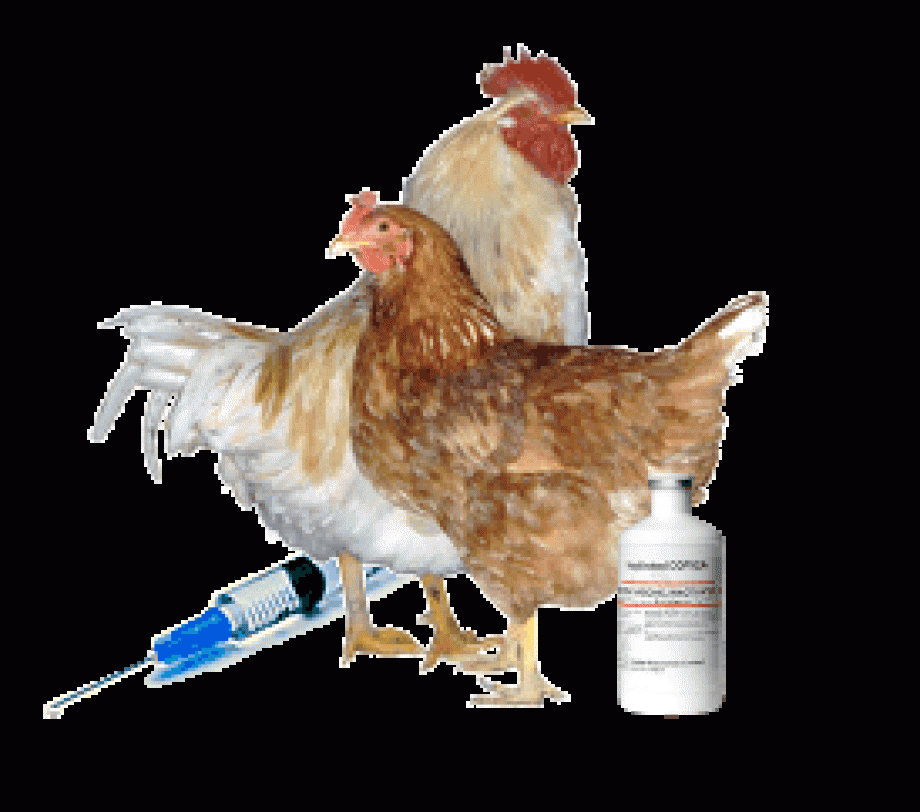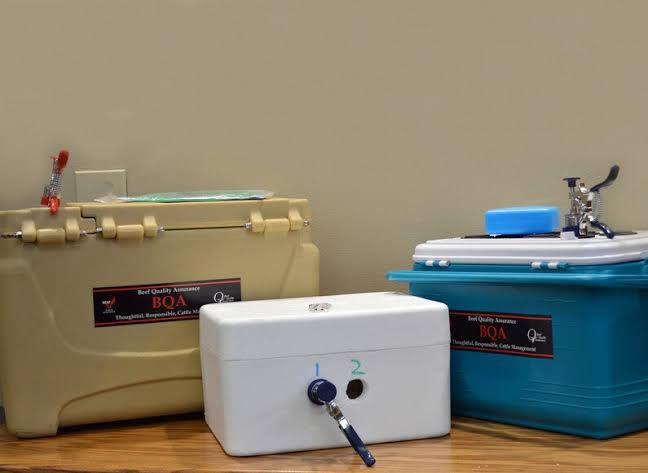This post is your guide to a successful vaccination program. Vaccination is the first line of action in preventing poultry diseases. No level of hygiene or other practices can substitute vaccination in terms of poultry disease prevention- Prevention is always better than cure.
In this post, you will find
- How vaccines prevent disease
- Types of vaccines
- Sites of administration
- Comprehensive vaccination schedules for layers and broilers
- Vaccination schedules in Nigeria (for layers and broilers)
- 8 tips for a successful vaccination

Poultry vaccines
Poultry Vaccination plays an important part in the health management of the poultry birds. Numerous diseases are prevented by vaccinating the birds against them. A vaccine helps to prevent a particular disease by stimulating the bird’s immune system to produce antibodies that in turn fight the invading causal organisms.

Chickens with vaccines Kitts
Poultry disease is one of the most difficult challenges in poultry farming. Therefore, there is a need for proper sensitization on biosecurity, feeding, management, and vaccination, if you wish to have a happy bird. Now let us look at how a vaccine works.
How do Vaccines Prevent Diseases?
Vaccines can prevent the spreading of dangerous diseases that affect both livestock and humans. Your safety, the safety of your poultry, and the safety of people who are going to contact the products of your farm depend on the health of your animals.

Illustration on how vaccines work
The principle of vaccination is in infecting a body with pathogenic organisms that have been properly processed in advance. These means allow the body to suffer the disease in the easiest possible form and create an immune response.
Next time when the body encounters the same pathogen, it will have a set of antibodies that will be able to fight the pathogen effectively. However, the effective immune response needs time to build up properly.
This is why all the living beings that are ever vaccinated should undergo this procedure in accordance with a certain schedule composed by specialists.
Types of vaccine For Chickens
Live Vaccine-
the active part of the vaccine is the live organism that causes the disease. As such, it is capable of inducing the disease in birds that have not had previous contact with the organism. Vaccinated birds in many cases can infect non-vaccinated birds if housed together.

A live vaccine of Fowlpox and its diluent
Attenuated vaccine-
with this type of vaccine, the organism has been weakened by special procedures during manufacture so that it has lost its ability to cause the serious form of the disease.
At worst, the birds may contract a very mild form of the disease, however, the vaccine still can trigger the immune system to produce antibodies
Killed vaccine-
with this type of vaccine the organism has been killed and is unable to cause the disease, although the ability to trigger the immune system remains.
In many cases, the level of immunity produced by this form of the vaccine is weaker than that produced by live and attenuated vaccines.
Safe Handling of Vaccines on the farm
Vaccines are fragile in many respects and require very careful handling to ensure they retain their potency. Poor handling procedures will, in most cases, result in a rapid decline of potency.
8 Tips for a successful Poultry Vaccination
1. On receipt of the vaccine on the farm, check and record:
- That the vaccine has been transported in the recommended manner which is usually in the chilled or frozen state.
- Type of vaccine- is it the vaccine ordered
- The number of doses- has the correct amount been delivered
- The expiry date of vaccine- after the date of expiration, the vaccine is at risk of losing its potency.
2. As soon as possible place the vaccine into recommended storage condition.
3. Remove the vaccine from storage immediately prior to its being used. Do not mix what is required for an entire day at the start of the day and leave it to stand until required, as the vaccine will rapidly lose its efficacy.
4. Protect the vaccine after mixing it by holding them in an ice bath. Place ice in a small or similar container and place the container of the mixed vaccine in the ice.
Some vaccines have a very short life once mixed. For example, Marek’s Disease has a life of about 1.5 hours after mixing if held in an ice bath. It is much shorter if held in higher temperatures
5. Use the recommended administration techniques and do not vary these without veterinary advice
6. Always clean and sterilize the vaccinating equipment thoroughly after use
7. Always destroy unused mixed vaccines after the task has been completed. Some vaccines have the potential to cause harm if not destroyed properly
8. Do not vaccinate birds that are showing signs of disease or stress.

Vaccine cold box
How to Give Vaccine in chicks
A vaccine is administered by a specialist using a poultry vaccination schedule. Various methods of administering vaccines include
- In ovo vaccination at 18 days of incubation using the patented Embrex InovoJect® system and alternatives
- Post-hatch sprays vaccination, in cabinets for mass-administration of aerosol vaccines to day-old chicks.
- Subcutaneous injection, using a manual or automatic syringe, to administer either live or inactivated emulsion vaccines to chicks, rearing stock, and breeders.
- Intramuscular injection, to administer inactivated aqueous and emulsion vaccines to replacement pullet or mature stock.
- Wing-web stab to administer live vaccines by the percutaneous route directly to each bird

Wing web Vaccination
- Aerosol administration, using a knapsack or electric sprayer to deliver the vaccine to flock as a coarse spray.
- Drinking water administration can be implemented at low cost but is of limited effectiveness against some infections.
- Eye drop and intranasal routes, requiring handling of individual chicks, are applied in hatcheries and during brooding of chicks.
Poultry Vaccination Schedule
One of the most important poultry vaccination principles is starting from the very beginning of their life and keeping on through the official program until the last one is done. Below, you will find a detailed schedule that will guide you through the effective and resultant poultry vaccination.
Comprehensive Vaccination Schedule for layers
| Age | Vaccine | Route | Type |
| 1 day | Mareks | Sc | herpesvirus and SB-1 |
| 14-21 days | Newcastle/infectious bronchitis | Water | B1/Mass |
| 14-21 days | Infectious bursal disease (Gumboro) | Water | Intermediate |
| 5 week | Newcastle/infectious bronchitis | Water or coarse spray | B1/Mass |
| 8 -10 week | Newcastle/infectious bronchitis | Water or coarse spray | B1 or LaSota/mass |
| 10-12 week | Encephalomyelitis | Wing web | Liver, chick-embryo origin |
| 10 - 12 week | Fowlpox | Wing web | Modified Live |
| 10 -12 week | Laryngotracheitis | Intraocular | Modified Live |
| 10 - 14 week | Mycopllasma gallisepticum | Intraocular or spray | Mild live strain |
| 12 - 14 week | Newcastle/infectious bronchitis | water or aerosol | B1 or LaSota/mass |
| 16 -18 week | Newcastle/infectious bronchitis | Water or aerosol | B1 or LaSota/mass |
| Every 60-90 days or 18 week | Newcastle/infectious bronchitis | Parenteral | Inactivated |
Source: www.msdvetmanual.com
a.This is an example of a vaccination program. Individual programs are highly variable and reflect local condition, disease prevalence, the severity of challenge, and individual
Comprehensive Vaccination Schedule for Broilers
| Vaccine | Age | Route | Type |
| Marek's disease | 1 day | SC | Turkey Herpesvirus and Sb -1 or Rispens strain for the high-challenge areas |
| Newcastle | 14 - 21 days | Coarse spray | B1 |
| 14 -21 days | water or Coarse spray | Intermediate B1 or Lasota | |
| Infectious bronchitis | 1 day | Coarse spray | Massachusetts |
| 14 -21 days | water or coarse spray | Massachusetts | |
| Infectious bursal disease | 14 - 21 days | water | intermediate |
Source: www.msdvetmanual.com
a. This is an example of a typical vaccination program. Individual programs are highly variable and reflect local conditions, disease prevalence, the severity of challenge, and individual preferences
b.Most USA commercial broiler hatcheries use an in ovo vaccination system for Marek's disease at17-19 days of embryonation. Infectious bursal disease vaccine (mild strain) may be combined with Marek's disease vaccines. Vectored vaccines in Which Marek's and fowlpox vaccines have been safely modified to carry immunizing antigens for laryngotracheitis, Newcastle disease, or infectious bursal disease are also commonly used in ovo or day-old chicks. Vaccination at 14-21 days is optional. A single drinking water application for Newcastle disease/bronchitis is also common.
How to confirm if your vaccine has worked
In some vaccines administration, it is important to confirm if the vaccine has worked, or is “taken”.
A good example of this is the fowlpox vaccine, which is administered by wing stab. Within 7 to 10 days after vaccination, a “ take” should appear at the vaccination site.
This is in the form of a small pimple one-half to one centimeter in diameter.

Injecting sites
However, If the take is larger and has a tacky core, it indicates that contaminants have been introduced either with the vaccine or with dirty vaccinating equipment. A check for takes would involve inspecting approximately 100 birds for every 10,000 vaccinated.
Nevertheless, if the vaccination has been unsuccessful, it may be necessary to re-vaccinate to obtain the desired protection.
3 Possible Reasons for Vaccine Failure in poultry
- Faulty technique resulting in the vaccine not being introduced into the vaccination site
- Faulty vaccine- too old or not stored or mixed correctly. It would be unusual but not impossible for the vaccine to be faulty from manufacture
- The birds are already immune i.e. the immune system has already been triggered as a result of parental (passive) immunity, previous vaccination, or other exposure to the causal organism.
In conclusion, vaccination is meant for preventive measures and not meant for the treatment of diseases. Make sure you follow the steps for safe handling of the vaccine on a farm for a successful vaccination program.
And most importantly, ensure you make use of the poultry vaccination schedule. Consult a specialist in areas that are highly technical.
If you find this article helpful, hit the comment box below.
And also please share on your social media, you might be helping someone out there.
Need a website or other IT services? Visit our website!
Share on Twitter Share on Facebook
Comments
Fadayomi Alexander 4 years, 10 months ago
May God bless you for this information. More wisdom.please send a copy to my email
Link | ReplySamuel Ezenwankwo 4 years, 10 months ago
Thanks . I will send it as soon as possible
Link | ReplyRuby 4 years, 9 months ago
Thanks again. Please send to my email address.
Link | ReplySamuel Ezenwankwo 4 years, 9 months ago
You're welcome
Link | ReplyOlayemi 4 years, 4 months ago
Pls can you send me the comprehensive vaccination schedule for both layers and broilers. And also which feed company is the best that you can recommend for both broilers and layers. Thanks
Link | ReplyComment awaiting approval 4 years, 3 months ago
Olukayode Savage 4 years, 2 months ago
Very comprehensive and lucid delivery. Could you possibly send a vaccination schedule for broilers to my email address. Many thanks.
Link | ReplyOpalek Taiwo 3 years, 9 months ago
Highly helpful. Thanks
Link | ReplyNew Comment